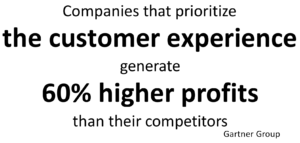
The single biggest piece of advice I give to senior executives setting out on the Customer Experience journey is to STOP. Yes seriously, the vast majority of CX efforts are completely misaligned.
CX Efforts Misaligned
Don’t get me wrong the intentions are good. Unfortunately, it goes something like this:
- Top Team are listening and decide they need to get with this customer centricity/Outside-In/working backwards thinking.

- Senior Management makes noises that the customer is THE thing the business must focus on.
- The Executive engage the marketing and sales guys to get with it and start pushing the message.
- Functional leaders hear the noise and bluster. They start using the language, whilst thinking this is just more fluff and nonsense. They make the right noises for now but keep their heads down, because they know this will go the same way as so many other ‘strategic initiatives’.
- Fundamentally functional heads carry on working with the out of date reward system that promotes sub-optimal industrial age thinking and practice.
- The Executive see the usual inertia, results not coming through, apathy and indifference and decide their business isn’t really an Amazon.
- Top Team then reverts to just getting better at what we are doing, then when someone in ‘our industry’ proves it we will follow.
- Functional leaders breathe a sigh of relief and invest even more in industrial age systems and training. The illusion of doing something, in this case, is actually worse than doing nothing.
- The businesses failure is noted by customers who move to those who do understand and deliver Customer Experience success.
- The company becomes another footnote in the history books. Talked about at business schools and picked apart because of the failure to get the new Outside-In customer-centric mindset.
Making Customer Experience Successful everywhere all the time
 This isn’t rocket science (unless you are NASA of course). Understanding that the structures and ways of working from the industrial age were NEVER designed to be customer-centric. They were established to make things faster by optimizing production lines.
This isn’t rocket science (unless you are NASA of course). Understanding that the structures and ways of working from the industrial age were NEVER designed to be customer-centric. They were established to make things faster by optimizing production lines.
And oh, don’t think because you are not in manufacturing you are OK. It is likely your complete ways of working will be making everything look like production management systems, with talk of leaning out, waste reduction, standardization, efficiency, productivity. Sound familiar?
Understanding this Customer Experience misalignment is fundamental.
I encourage doing three things before re-joining the CX road-march:
- Understand how big the gap is between what you are doing and what Successful Customer Outcomes you need to be delivering.
- Audit the current key performance indicators.
Are they mostly about outputs?
Usually, the balance will be 80% output metrics (like calls answered, Average Handle Times, Abandoned Rates, Projects completed on time to budget etc.).
Meanwhile, the really important measures that tell you a Successful Customer Outcome is being achieved will only be a small proportion.
What you measure is what you get and no amount of Customer Experience drum banging will work unless those measures of Outcomes become the most important. - Create an awareness of what real CX success is all about.
This isn’t just the stories. It is about the actual things on the ground that need to change. The WHY and the HOW go hand in hand. Often times upskilling a group of key players at all levels to make them Ambassadors for the Customer achieves way more than massive corporate investment in branding and image.
In conclusion, Customer Experience cannot be treated just like another corporate initiative. To achieve success requires a significant shift in mindsets, and when that is achieved the realignment of the Enterprise to Outside-In can really begin.
Want more guidance and tips like this?
☑ More Articles like this one – visit my CX Obsession resources
☑ Upskilling and mentoring – Every level from the boardroom to the lunch room – BP Group
☑ In person and virtual training – The ACXM™ program
☑ Executive briefings and keynotes – How to get your hands on me and other CXperts (see what I did there?)


